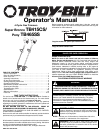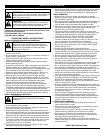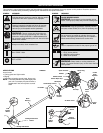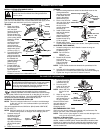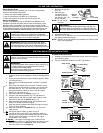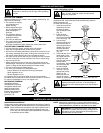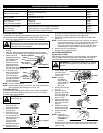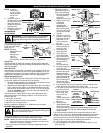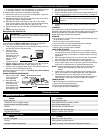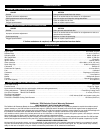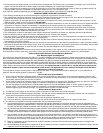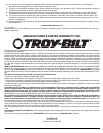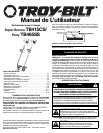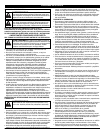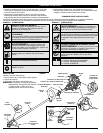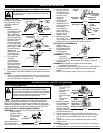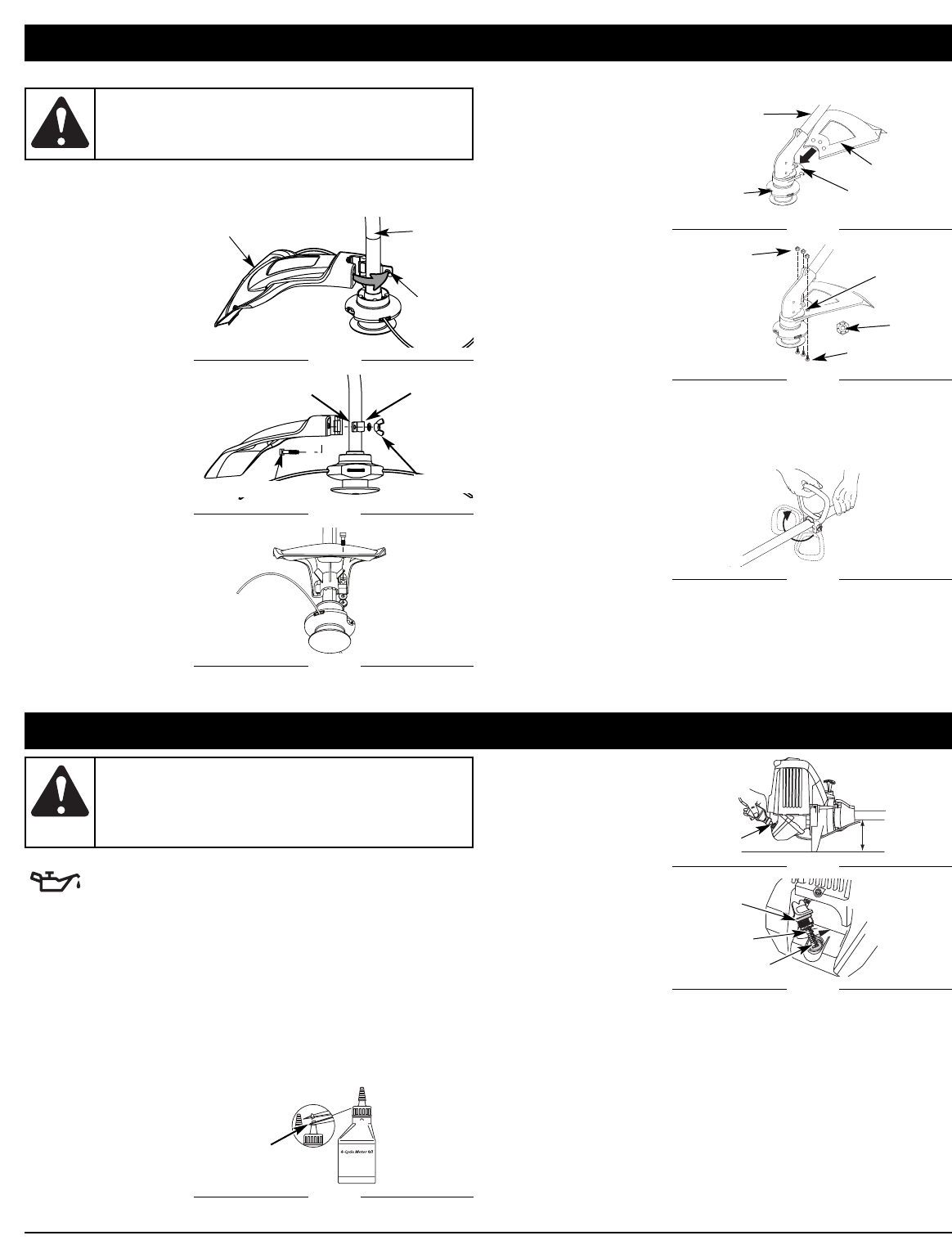
ASSEMBLY INSTRUCTIONS
OIL AND FUEL INFORMATION
4
INSTALL CUTTING ATTACHMENT SHIELD
Use the following instructions if the cutting attachment shield on
your unit is not installed. Use only the instructions that apply to the
type of shaft and shield that your unit is equipped with.
TB415CS
1. Place the cutting
attachment shield
onto the shaft
housing. Be sure the
guard mounting
bracket slides into
the slot on the edge
of the cutting shield.
Rotate the shield
into place,
counterclockwise.
The holes in the
guard mounting
bracket and cutting
attachment shield
will line up (Fig. 1).
2. F
rom inside the cutting
attachment shield,
push the square bolt
through the hole until
the threaded end
protrudes through the
guard mounting
bracket (Fig. 2).
3. Put the washer on
the bolt, then screw
the wing nut onto the
bolt and tighten.
Figure 3 shows the
installation process from underneath the unit.
WARNING:
To prevent serious personal injury, never
operate the trimmer without the cutting attachment
shield in place.
Fig. 1
Shaft
Housing
Guard
Mounting
Bracket
Cutting Attachment
Shield
Guard Mounting
Bracket
Washer
Wing Nut
Square Bolt
Fig. 2
Square Bolt
Fig. 3
TB465SS
1. Slide the cutting attachment shield into the shield mount on the
cutting attachment.
Align the screw holes
in the shield with the
holes in the cutting
attachment (Fig. 4).
2. Place a hex lock nut
into one of the three
recessed holes on
the top of the
cutting attachment
shield (Fig 5).
3.
Install a screw into the
hole from the bottom
of the cutting
attachment shield and
screw it into the nut
installed in step 2 (Fig.
5). Do not tighten.
4. Repeat steps 2 and
3 until all three screws have been started, then tighten securely.
ADJUSTING THE D-HANDLE
1. Locate the wing nut on the D-Handle. Loosen the wing nut
enough to loosen the
D-Handle (Fig. 6).
NOTE: Do not remove
wing nut,
washer, or bolt.
2. Rotate the D-Handle
to the upright
position on the front
side of the shaft
housing (Fig. 6).
NOTE: The D-handle should slant towards the powerhead of the
unit.
3. Hold the unit in the operating position (Fig. 15). If necessary,
reposition the D-handle to the location that provides the best grip.
4. Tighten the wing nut until the D-Handle is secure.
Shaft Housing
Shield
Mount
Cutting
Attachment
Shield
Cutting
Attachment
Fig. 4
Recessed
Holes
Hex Lock
Nut
Screws (3)
Nuts (3)
Fig. 5
Fig. 6
WARNING:
O
VERFILLING OIL CRANKCASE MAY
CAUSE SERIOUS PERSONAL INJURY. Check and maintain
the proper oil level in the crank case; it is important and
cannot be overemphasized. Check the oil before each use
and change it as needed. See Changing the Oil.
RECOMMENDED OIL TYPE
Using the proper type and weight of oil in the crankcase is
extremely important. Check the oil before each use and change
the oil regularly. Failure to use the correct oil, or using dirty oil, can cause
premature engine wear and failure. Use a high-quality SAE 30 weight oil of
API (American Petroleum Institute) service class SF, SG, SH.
ADDING OIL TO CRANKCASE: INITIAL USE
NOTE: This unit is shipped without oil. In order to avoid damage
to the unit, put oil in the crankcase before you attempt to
start the unit.
Your unit is supplied with one 3.04 fluid oz. (90 ml) bottle of SAE 30 SF,
SG, SH oil (Fig. 7).
NOTE: Save the bottle of oil. It can be used to measure the correct
amount during future oil changes. See Changing the Oil.
1. Unscrew the top of
the bottle of oil and
remove the paper
seal covering the
opening. Replace the
top. Next, cut the tip
off the funnel spout
(Fig. 7).
2. Place the unit on a flat level surface (Fig. 8).
3. Remove the oil plug
/ dipstick from the
crankcase (Fig. 9).
4. Pour the entire
bottle of oil into the
oil fill hole (Fig. 9).
NOTE: Never add oil to
the fuel or fuel
tank.
5. Wipe up any oil that
may have spilled
and reinstall the oil
fill plug / dipstick.
Check oil before each
use and change as
needed. Refer to
Changing the Oil.
RECOMMENDED FUEL TYPE
Old fuel is the primary reason for improper unit performance. Be
sure to use fresh, clean, unleaded gasoline.
NOTE: This is a four cycle engine. In order to avoid damage to the
unit, do not mix oil with gasoline.
Definition of Blended Fuels
Today's fuels are often a blend of gasoline and oxygenates such as
ethanol, methanol or MTBE (ether). Alcohol-blended fuel absorbs water.
As little as 1% water in the fuel can make fuel and oil separate or form
acids when stored. Use fresh fuel (less than 60 days old), when using
alcohol-blended fuel.
Fig. 7
Funnel
Spout
Fig. 8
Oil Fill
Fig. 9
Oil Fill
Plug/Dipstick
O-Ring
Oil Fill Hole



